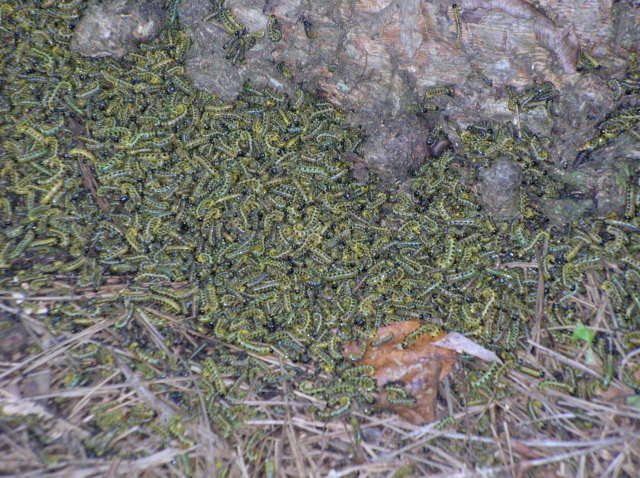Question base of tree worms
base of tree worms
QUESTION: I have pictures of these worms who are falling out of our River Birch trees. These worms have been in other trees in our yard. These happen to be pictures of a cluster of these who at the base of the tree. They fall on the ground, on other bushes, and are crawling up the fence & along our concrete curbing. They have stripped the trees of their leaves. When you are within 15 yards of the trees you can hear objects hitting the ground. This may be their poop?
ANSWER: The caterpillars are migrating to find a place to spin their cocoons. They have done their damage eating the foliage and now will pupate and turn into moths and lay more eggs to hatch next year. I would spray the caterpillars with an insecticide called Sevin. This is a contact insecticide and will kill them preventing moth and eggs next year.
The trees will leaf back out next spring. Hardwoods are not killed by defoliation unless it happens several years in a row. Then you will get some dieback of branches. Next spring treat the trees with an insecticide called Bayer Advanced Tree and Shrub Insect Control. This is applied to the soil around the tree and the roots will transport it to the leaves and when the caterpillars hatch out and start to eat the leaf they are killed. It will protect the tree throughout the season. Here is a web link to this product. Check with your local nursery for these products.
http://www.bayeradvanced.com/product/Tree-Shrub-Insect-Control/concentrate.html
---------- FOLLOW-UP ----------
QUESTION: There are not any cocoons or webs on the trees. There were cocoons or webs last year, but nothing this year. We were told these webs were tent caterpillars. The bottom line is these caterpillars are the result of webs from last year. Correct? These caterpillars are also on other bushes. Do we put Bayer Advanced Tree and Shrub Control on every shrub & tree in the back yard?
AnswerThese caterpillars are not from the webs last year. If there was not web this year this caterpillar is different than those in the web. If it is on other species of trees it is not the dusky sawfly. These sounds like maybe yellownecked caterpillar. With out a good close up of the caterpillar it is difficult to ID which one you have.
The yellownecked caterpillar occurs commonly on oaks but will feed on several trees and shrubs, including apple, basswood, birch, honeylocust, and maple. The larvae typically feed in colonies, defoliating one branch, then moving as a group to another. Young larvae are basically red with yellow or white stripes; the full-grown larva is about two inches long, black with similar longitudinal stripes, and has a yellow collar or "neck" behind the head. Caterpillars are normally present from late July or early August until mid-October. There is only one generation per year.
I would spray the tree if you can with Orthene or if the trees are too large to spray use the Bayer Advanced. yes it can be used on any of the trees. But I would only use it on the tree that have the caterpillars on them now. These trees more than likely are the preferred species for the caterpillar and treating other tree would be a waste of money.
The contact spray would be best now since the caterpillars have for the most part finished feeding and will soon spin cocoons. Spray the trunks of the tree and when the caterpillar walks through the insecticide it will be killed. Any groups of caterpillars should be sprayed. Then next spring use the Bayer product on the trees that had caterpillar damage this year to prevent their eating the leaves next year.
The cocoons are not the webs that cover the branches but individual webbing. These are mainly in the ground or under the leaf litter layer or in bark crevices down low on the trunk.
I hope I have not confused the issue.
Recap
Spray the caterpillars that are grouped up and the tree trunks with Orthene Insecticide and next year treat the trees that were defoliated with the Bayer product.






